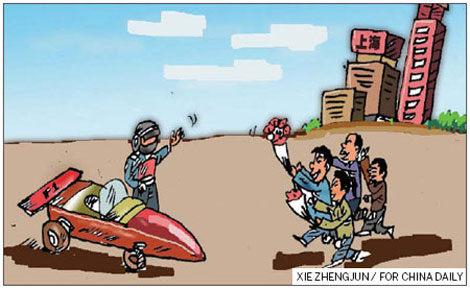Cars
Formula 1 a good fit for China aspirations
Updated: 2011-04-08 11:07
By Matthew Marsh (China Daily European Weekly)

The inaugural Chinese Formula 1 Grand Prix in 2004 was an example of the sport heading east in search of countries willing to pay the ever-increasing rights fees to put themselves "on the map". However, as the Chinese economy develops, the event's commercial importance is growing and its inclusion on the calendar more important.
Of the 20 races scheduled this season, six are in Asia. Following Japan (1976), Malaysia (1999) and China have come Singapore (2008), South Korea (2010) and - new this year - India. Formula Money's Caroline Reid estimates the average hosting fee for races added to the calendar in the past decade is $44 million versus an average of $31 million across the whole season.
Jiang Lan of race promoter Juss Events is clear about the value of the Grand Prix: "It is a calling card for Shanghai which opens PR channels both for the country and the city, creates an ideal opportunity for the government and entrepreneurs to interact, develops local tourism - and promotes local brands on the international stage."
Juss is essentially the sports marketing arm of the Shanghai local government. It is owned by Jiu Shi Corporation, a State-owned company which controls 80 percent of the public transport infrastructure in the city and various real estate including the F1 circuit.
Where China differs from some of the other recently added F1 venues (for example the race in Bahrain postponed this year due to political turmoil) is the size and increasing relevance of its local market. As Jiang of Juss Events describes it "mutually beneficial cooperation between F1 and Shanghai; F1 needed the race to broaden its market, whilst we needed to bring more attention to Shanghai as an international city".
F1 has become a platform matched in scale and reach only by the Olympic Games and the FIFA World Cup. Yet whilst these are one-off quadrennial events F1's calendar stretches almost throughout the year and visits 19 countries - making it both local and global. During the 2010 season there were 527 million individual television viewers who watched at least 15 minutes of one Grand Prix. China delivered 75 million of these, representing an impressive 14 percent of the total.
The young and highly educated (segments attractive to marketers) are heavily represented in China's F1 audience. Yet so far there has not been much evidence of brands using F1 for promotion in China.
Perhaps this is because the viewing figures pale against those for some other sports. Whilst the highest single-event audience in China during 2010 was 15 million (for the season-opening Bahrain GP) there were a staggering 110 million who watched Ding Junhui beat Stephen Hendry in the final match of 2005 China Open snooker in Beijing. And matches regularly have over 70 million viewers, says Simon Leach, who ran World Snooker's China office. The obvious difference is that snooker is a more accessible sport which has Chinese players competing at the top level.
Kenny Hau of advertising media company GroupM says its proprietary data shows that "although interest levels in F1 are strong and growing in Asia they remain inferior to other genres - most obviously football in Southeast Asia, cricket in India and basketball in China". Hau believes successful sponsorships need an appropriate fit and relevance between the sport, brand and audience.
Peter Tan of United Parcel Service agrees. After being a sponsor of China's men's basketball team for the 2008 Beijing Olympic Games, UPS widened its investment to include the China Basketball Association league. "It's ingrained in the Chinese mentality," says Tan of the sport. "The league has a huge footprint with tons of games all over the country." An important attraction is the city-based teams which, "resonate from the receptionist up to the CEO".
Yet whilst motor sport does not have a mass following in China, Tom Moser of specialist marketing agency JMI believes F1 presents an unusual opportunity. "The fan base in the PRC is relatively small but is drawn from an attractive demographic of young, wealthy, educated opinion leaders. But much more exciting are those who do not follow the sport. The attributes this broad spectrum of people consistently associate with F1 are positive and include words like, 'international', 'sophisticated', 'performance', 'glamour' and 'technology'. "
That first F1 race in Shanghai, in September 2004, set an attendance record for China of 260,000 (for the three days). Attention waned thereafter but Juss Events is using its experience with the successful Shanghai Rolex Masters tennis tournament (the first and only ATP Masters Series event in Asia) to improve promotion of the Grand Prix and its relevance to local people.
With Formula One Management recently confirming Shanghai's place on the calendar through 2017 - and Swiss bank UBS taking the title sponsorship of the Grand Prix - there are a number of reasons to be optimistic about the importance of China to F1.
After a successful career on the track, the author now works at JMI - the world's leading motor sport marketing company. He can be reached at: mmarsh@justmarketing.com.
Specials

Share your China stories!
Foreign readers are invited to share your China stories.

Art auctions
China accounted for 33% of global fine art sales.

Waiting for drivers' seat
Lack of sponsorship appears to be why Chinese drivers have yet to race in a Formula 1 event